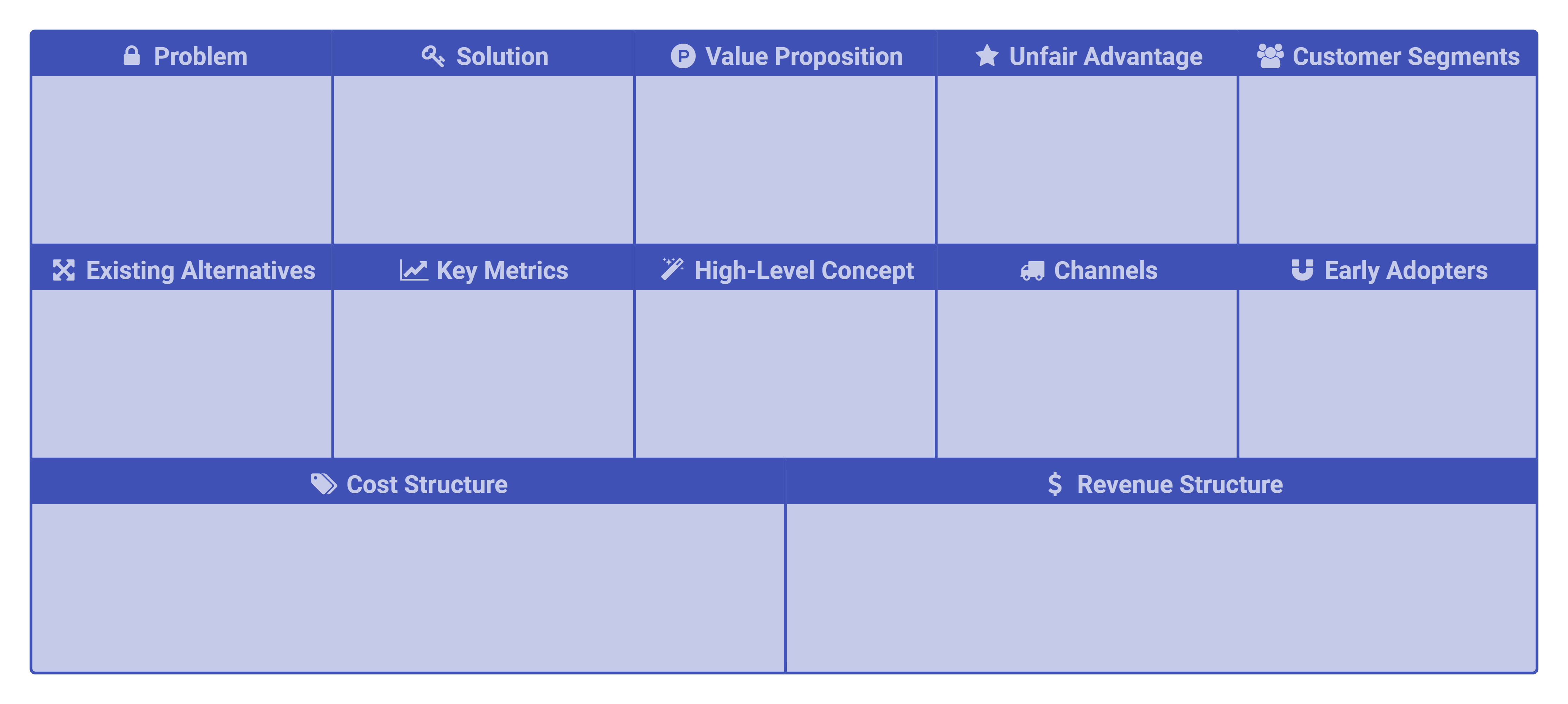What is the Lean Canvas?
The Lean Canvas is a version of the Business Model Canvas which is particularly aimed at startups still in the idea stage.
It was developed by Ash Maurya as an alternative to the business plan and to help entrepreneurs and startups to quickly outline and iterate their business idea, and to develop and test hypotheses for validation.
The Lean Canvas is based on the principles of the Lean Startup methodology, which emphasizes building a Minimum Viable Product (MVP) to quickly validate assumptions and gather feedback from customers.
 What does the Lean Canvas look like?
What does the Lean Canvas look like?
The Lean Canvas itself is a one-page visual representation that captures 12 key elements of a business idea. These elements include:
-
Problem: List the top problems or pain points (up to about 3) your target customers are experiencing. Identify the challenges that your business aims to solve, using evidence from market research or customer feedback. Sort them in order of importance.
-
Solution: An outline of your proposed solution to the identified problem. This should directly address the Problem as described to the left.
- Existing Alternatives: How prospective customers currently deal with this problem. This could include competition solutions or steps target customers take to avoid the problem or solve it themselves.
-
Key Metrics: The measurable indicators that will help you track the success and growth of your business. Consider the performance of your solution, the acquisition and retention (or churn) of customers and measures of financial success.
-
Unique Value Proposition (UVP): A concise statement that communicates the unique benefits your product or service offers to customers, and why they should choose it over any alternatives or competitors.
- High-Level Concept: Usually expressed by comparison to other solutions, such as:
- Airbnb is "the Uber of travel accommodation".
- YouTube is “Flickr for video”.
- Aliens (the movie) is “Jaws in space”.
- Dogster is “Friendster for dogs”.
-
Unfair Advantage: Factors that give your business a competitive edge or barriers to entry that make it difficult for others to replicate your success. This could range from personal experience to a unique brand, proprietary technology or exclusive partnerships.
-
Channels: The different ways you plan to reach and acquire customers. This includes marketing, distribution and sales channels that will be used to deliver your value proposition to customers.
-
Customer Segments: Clearly identify your target audience and the specific groups of customers you intend to serve. These groups should experience the problem. The solution should be suitable for them. Include details of the demographic, such as numbers and growth rates.
- Early Adopters: Early adopters are those customer sub-segments most likely to be willing to try your product or service first. They are a valuable source of validation and may influence other customers to follow suit. What characteristics are they likely to exhibit?
-
Revenue Streams: How you plan to generate revenue from your product or service. Include pricing strategy, revenue model (like subscription, one-time sale, freemium, after-sales charges) and any other sources of income. You can also itemise revenue items, which will then be incorporated into your financial projection.
-
Cost Structure: The key expenses associated with operating your business. Include everything from startup costs, operational expenses and customer acquisition costs. You can also itemise costs, which will then be incorporated into your financial projection.
Relationship to the Business Model Canvas
There are several key elements on the Lean Canvas which are common to the Business Model Canvas:
- Customer Segments
- Channels
- Value Proposition
- Cost Structure and Revenue Structure
Data captured in these common elements in Lean Canvas will be automatically carried over to the Business Model Canvas and vice versa.
Integrating with Strategy
A Lean Canvas developing into a Business Model Canvas may be a good starting point for a strategy. But they are not a strategy in themselves.
Fortunately, because the Lean Canvas is integrated into the broader StratNavApp.com framework, you can easily use a Lean Canvas as the starting point for developing a more complete strategy.
For example, you can:
- Link Actions to any one or more elements on the Lean Canvas to validate them.
- Link Strategic Initiatives to any one or more elements on the Lean Canvas to build, acquire, launch and/or improve them.
- Link Strategic Insights to any one or more elements on the Lean Canvas to create a deeper understanding of the business strategy required.
- Include Key Metrics defined on the Lean Canvas on your Strategic Scorecard.
Each of these will then automatically be carried forward into the many other tools and frameworks in StratNavApp.com which will help you further develop and execute your business strategy.
Using the Lean Canvas when starting a new business
-
Think long and hard about your answers in each of those categories. Especially: What assumptions are you making? Then, test those assumptions by talking to as many people as you can: customers, distributors, suppliers, other people in the market etc.
-
If these conversations don't support your assumptions, change your assumptions and your Lean Canvas.
-
Keep going until you have a Lean Canvas that makes sense based on assumptions that stack up.
-
Then start building, but start small, grow and adapt. Plan your Strategic Initiatives and Actions and track them through to completion.
Where to find the Lean Canvas
To find your Lean Canvas:
- Sign in to StratNavApp.com.
- Select the project you want to work with.
- Click on "Analysis" on the main menu.
- Click on "Business Model" on the drop-down menu that opens up.
- Select "Lean Canvas" on the model selector on the page that follows.
